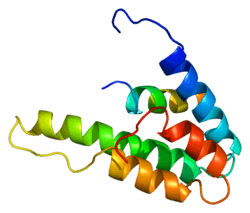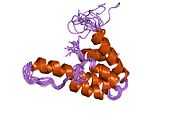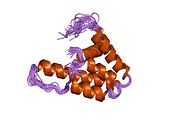SIN3A
Paired amphipathic helix protein Sin3a is a protein that in humans is encoded by the SIN3A gene.[1][2]
Function
The protein encoded by this gene is a transcriptional regulatory protein. It contains paired amphipathic helix (PAH) domains, which are important for protein-protein interactions and may mediate repression by the Mad-Max complex.[3]
Interactions
SIN3A has been shown to interact with:
- CABIN1[4]
- HBP1,[5]
- HDAC1,[6][7][8][9][10][11][12][13][14][15][16][17][18][19]
- HDAC9,[20][21]
- Histone deacetylase 2,[6][8][9][14][15][22][23]
- Host cell factor C1,[24][25]
- IKZF1,[20][26][27]
- ING1,[19]
- KLF11,[28][29]
- MNT,[30]
- MXD1,[5][31][32]
- Methyl-CpG-binding domain protein 2,[33]
- Nuclear receptor co-repressor 2,[18][34]
- OGT,[35]
- PHF12,[36]
- Promyelocytic leukemia protein,[37]
- RBBP4,[38][39]
- RBBP7,[19][39]
- SAP130,[8]
- SAP30,[8][13][19][36][39][40]
- SMARCA2,[41]
- SMARCA4,[19][41]
- SMARCC1,[19][41]
- SUDS3,[8][42]
- TAL1,[43] and
- Zinc finger and BTB domain-containing protein 16.[44][45][46]
See also
References
- ↑ Yu F, Thiesen J, Stratling WH (June 2000). "Histone deacetylase-independent transcriptional repression by methyl-CpG-binding protein 2". Nucleic Acids Res 28 (10): 2201–6. doi:10.1093/nar/28.10.2201. PMC 105362. PMID 10773092.
- ↑ Halleck MS, Pownall S, Harder KW, Duncan AM, Jirik FR, Schlegel RA (August 1995). "A widely distributed putative mammalian transcriptional regulator containing multiple paired amphipathic helices, with similarity to yeast SIN3". Genomics 26 (2): 403–6. doi:10.1016/0888-7543(95)80229-F. PMID 7601471.
- ↑ "Entrez Gene: SIN3A SIN3 homolog A, transcription regulator (yeast)".
- ↑ Youn HD, Liu JO (2000). "Cabin1 represses MEF2-dependent Nur77 expression and T cell apoptosis by controlling association of histone deacetylases and acetylases with MEF2". Immunity 13 (1): 85–94. doi:10.1016/S1074-7613(00)00010-8. PMID 10933397.
- ↑ 5.0 5.1 Swanson KA, Knoepfler PS, Huang K, Kang RS, Cowley SM, Laherty CD, Eisenman RN, Radhakrishnan I (2004). "HBP1 and Mad1 repressors bind the Sin3 corepressor PAH2 domain with opposite helical orientations". Nat. Struct. Mol. Biol. 11 (8): 738–46. doi:10.1038/nsmb798. PMID 15235594.
- ↑ 6.0 6.1 Zhang Y, Dufau ML (2003). "Dual mechanisms of regulation of transcription of luteinizing hormone receptor gene by nuclear orphan receptors and histone deacetylase complexes". J. Steroid Biochem. Mol. Biol. 85 (2-5): 401–14. doi:10.1016/S0960-0760(03)00230-9. PMID 12943729.
- ↑ Yao YL, Yang WM (2003). "The metastasis-associated proteins 1 and 2 form distinct protein complexes with histone deacetylase activity". J. Biol. Chem. 278 (43): 42560–8. doi:10.1074/jbc.M302955200. PMID 12920132.
- ↑ 8.0 8.1 8.2 8.3 8.4 Fleischer TC, Yun UJ, Ayer DE (2003). "Identification and characterization of three new components of the mSin3A corepressor complex". Mol. Cell. Biol. 23 (10): 3456–67. doi:10.1128/MCB.23.10.3456-3467.2003. PMC 164750. PMID 12724404.
- ↑ 9.0 9.1 Yang L, Mei Q, Zielinska-Kwiatkowska A, Matsui Y, Blackburn ML, Benedetti D, Krumm AA, Taborsky GJ, Chansky HA (2003). "An ERG (ets-related gene)-associated histone methyltransferase interacts with histone deacetylases 1/2 and transcription co-repressors mSin3A/B". Biochem. J. 369 (Pt 3): 651–7. doi:10.1042/BJ20020854. PMC 1223118. PMID 12398767.
- ↑ Grozinger CM, Hassig CA, Schreiber SL (1999). "Three proteins define a class of human histone deacetylases related to yeast Hda1p". Proc. Natl. Acad. Sci. U.S.A. 96 (9): 4868–73. doi:10.1073/pnas.96.9.4868. PMC 21783. PMID 10220385.
- ↑ Zhang J, Kalkum M, Chait BT, Roeder RG (2002). "The N-CoR-HDAC3 nuclear receptor corepressor complex inhibits the JNK pathway through the integral subunit GPS2". Mol. Cell 9 (3): 611–23. doi:10.1016/S1097-2765(02)00468-9. PMID 11931768.
- ↑ You A, Tong JK, Grozinger CM, Schreiber SL (2001). "CoREST is an integral component of the CoREST- human histone deacetylase complex". Proc. Natl. Acad. Sci. U.S.A. 98 (4): 1454–8. doi:10.1073/pnas.98.4.1454. PMC 29278. PMID 11171972.
- ↑ 13.0 13.1 Zhang Y, Ng HH, Erdjument-Bromage H, Tempst P, Bird A, Reinberg D (1999). "Analysis of the NuRD subunits reveals a histone deacetylase core complex and a connection with DNA methylation". Genes Dev. 13 (15): 1924–35. doi:10.1101/gad.13.15.1924. PMC 316920. PMID 10444591.
- ↑ 14.0 14.1 Zhang Y, Dufau ML (2002). "Silencing of transcription of the human luteinizing hormone receptor gene by histone deacetylase-mSin3A complex". J. Biol. Chem. 277 (36): 33431–8. doi:10.1074/jbc.M204417200. PMID 12091390.
- ↑ 15.0 15.1 Tong JK, Hassig CA, Schnitzler GR, Kingston RE, Schreiber SL (1998). "Chromatin deacetylation by an ATP-dependent nucleosome remodelling complex". Nature 395 (6705): 917–21. doi:10.1038/27699. PMID 9804427.
- ↑ Hassig CA, Tong JK, Fleischer TC, Owa T, Grable PG, Ayer DE, Schreiber SL (1998). "A role for histone deacetylase activity in HDAC1-mediated transcriptional repression". Proc. Natl. Acad. Sci. U.S.A. 95 (7): 3519–24. doi:10.1073/pnas.95.7.3519. PMC 19868. PMID 9520398.
- ↑ Yasui D, Miyano M, Cai S, Varga-Weisz P, Kohwi-Shigematsu T (2002). "SATB1 targets chromatin remodelling to regulate genes over long distances". Nature 419 (6907): 641–5. doi:10.1038/nature01084. PMID 12374985.
- ↑ 18.0 18.1 Huang EY, Zhang J, Miska EA, Guenther MG, Kouzarides T, Lazar MA (2000). "Nuclear receptor corepressors partner with class II histone deacetylases in a Sin3-independent repression pathway". Genes Dev. 14 (1): 45–54. PMC 316335. PMID 10640275.
- ↑ 19.0 19.1 19.2 19.3 19.4 19.5 Kuzmichev A, Zhang Y, Erdjument-Bromage H, Tempst P, Reinberg D (2002). "Role of the Sin3-histone deacetylase complex in growth regulation by the candidate tumor suppressor p33(ING1)". Mol. Cell. Biol. 22 (3): 835–48. doi:10.1128/MCB.22.3.835-848.2002. PMC 133546. PMID 11784859.
- ↑ 20.0 20.1 Koipally J, Georgopoulos K (2002). "Ikaros-CtIP interactions do not require C-terminal binding protein and participate in a deacetylase-independent mode of repression". J. Biol. Chem. 277 (26): 23143–9. doi:10.1074/jbc.M202079200. PMID 11959865.
- ↑ Petrie K, Guidez F, Howell L, Healy L, Waxman S, Greaves M, Zelent A (2003). "The histone deacetylase 9 gene encodes multiple protein isoforms". J. Biol. Chem. 278 (18): 16059–72. doi:10.1074/jbc.M212935200. PMID 12590135.
- ↑ Hakimi MA, Dong Y, Lane WS, Speicher DW, Shiekhattar R (2003). "A candidate X-linked mental retardation gene is a component of a new family of histone deacetylase-containing complexes". J. Biol. Chem. 278 (9): 7234–9. doi:10.1074/jbc.M208992200. PMID 12493763.
- ↑ Laherty CD, Yang WM, Sun JM, Davie JR, Seto E, Eisenman RN (1997). "Histone deacetylases associated with the mSin3 corepressor mediate mad transcriptional repression". Cell 89 (3): 349–56. doi:10.1016/S0092-8674(00)80215-9. PMID 9150134.
- ↑ Yokoyama A, Wang Z, Wysocka J, Sanyal M, Aufiero DJ, Kitabayashi I, Herr W, Cleary ML (2004). "Leukemia proto-oncoprotein MLL forms a SET1-like histone methyltransferase complex with menin to regulate Hox gene expression". Mol. Cell. Biol. 24 (13): 5639–49. doi:10.1128/MCB.24.13.5639-5649.2004. PMC 480881. PMID 15199122.
- ↑ Wysocka J, Myers MP, Laherty CD, Eisenman RN, Herr W (2003). "Human Sin3 deacetylase and trithorax-related Set1/Ash2 histone H3-K4 methyltransferase are tethered together selectively by the cell-proliferation factor HCF-1". Genes Dev. 17 (7): 896–911. doi:10.1101/gad.252103. PMC 196026. PMID 12670868.
- ↑ Koipally J, Renold A, Kim J, Georgopoulos K (1999). "Repression by Ikaros and Aiolos is mediated through histone deacetylase complexes". EMBO J. 18 (11): 3090–100. doi:10.1093/emboj/18.11.3090. PMC 1171390. PMID 10357820.
- ↑ Koipally J, Georgopoulos K (2002). "A molecular dissection of the repression circuitry of Ikaros". J. Biol. Chem. 277 (31): 27697–705. doi:10.1074/jbc.M201694200. PMID 12015313.
- ↑ Zhang JS, Moncrieffe MC, Kaczynski J, Ellenrieder V, Prendergast FG, Urrutia R (2001). "A conserved alpha-helical motif mediates the interaction of Sp1-like transcriptional repressors with the corepressor mSin3A". Mol. Cell. Biol. 21 (15): 5041–9. doi:10.1128/MCB.21.15.5041-5049.2001. PMC 87230. PMID 11438660.
- ↑ Ellenrieder V, Zhang JS, Kaczynski J, Urrutia R (2002). "Signaling disrupts mSin3A binding to the Mad1-like Sin3-interacting domain of TIEG2, an Sp1-like repressor". EMBO J. 21 (10): 2451–60. doi:10.1093/emboj/21.10.2451. PMC 126002. PMID 12006497.
- ↑ Meroni G, Reymond A, Alcalay M, Borsani G, Tanigami A, Tonlorenzi R, Lo Nigro C, Messali S, Zollo M, Ledbetter DH, Brent R, Ballabio A, Carrozzo R (1997). "Rox, a novel bHLHZip protein expressed in quiescent cells that heterodimerizes with Max, binds a non-canonical E box and acts as a transcriptional repressor". EMBO J. 16 (10): 2892–906. doi:10.1093/emboj/16.10.2892. PMC 1169897. PMID 9184233.
- ↑ Brubaker K, Cowley SM, Huang K, Loo L, Yochum GS, Ayer DE, Eisenman RN, Radhakrishnan I (2000). "Solution structure of the interacting domains of the Mad-Sin3 complex: implications for recruitment of a chromatin-modifying complex". Cell 103 (4): 655–65. doi:10.1016/S0092-8674(00)00168-9. PMID 11106735.
- ↑ Ayer DE, Lawrence QA, Eisenman RN (1995). "Mad-Max transcriptional repression is mediated by ternary complex formation with mammalian homologs of yeast repressor Sin3". Cell 80 (5): 767–76. doi:10.1016/0092-8674(95)90355-0. PMID 7889570.
- ↑ Boeke J, Ammerpohl O, Kegel S, Moehren U, Renkawitz R (2000). "The minimal repression domain of MBD2b overlaps with the methyl-CpG-binding domain and binds directly to Sin3A". J. Biol. Chem. 275 (45): 34963–7. doi:10.1074/jbc.M005929200. PMID 10950960.
- ↑ Li J, Wang J, Wang J, Nawaz Z, Liu JM, Qin J, Wong J (2000). "Both corepressor proteins SMRT and N-CoR exist in large protein complexes containing HDAC3". EMBO J. 19 (16): 4342–50. doi:10.1093/emboj/19.16.4342. PMC 302030. PMID 10944117.
- ↑ Yang X, Zhang F, Kudlow JE (2002). "Recruitment of O-GlcNAc transferase to promoters by corepressor mSin3A: coupling protein O-GlcNAcylation to transcriptional repression". Cell 110 (1): 69–80. doi:10.1016/S0092-8674(02)00810-3. PMID 12150998.
- ↑ 36.0 36.1 Yochum GS, Ayer DE (2001). "Pf1, a novel PHD zinc finger protein that links the TLE corepressor to the mSin3A-histone deacetylase complex". Mol. Cell. Biol. 21 (13): 4110–8. doi:10.1128/MCB.21.13.4110-4118.2001. PMC 87072. PMID 11390640.
- ↑ Khan MM, Nomura T, Kim H, Kaul SC, Wadhwa R, Shinagawa T, Ichikawa-Iwata E, Zhong S, Pandolfi PP, Ishii S (2001). "Role of PML and PML-RARalpha in Mad-mediated transcriptional repression". Mol. Cell 7 (6): 1233–43. doi:10.1016/S1097-2765(01)00257-X. PMID 11430826.
- ↑ Hassig CA, Fleischer TC, Billin AN, Schreiber SL, Ayer DE (1997). "Histone deacetylase activity is required for full transcriptional repression by mSin3A". Cell 89 (3): 341–7. doi:10.1016/S0092-8674(00)80214-7. PMID 9150133.
- ↑ 39.0 39.1 39.2 Zhang Y, Sun ZW, Iratni R, Erdjument-Bromage H, Tempst P, Hampsey M, Reinberg D (1998). "SAP30, a novel protein conserved between human and yeast, is a component of a histone deacetylase complex". Mol. Cell 1 (7): 1021–31. doi:10.1016/S1097-2765(00)80102-1. PMID 9651585.
- ↑ Laherty CD, Billin AN, Lavinsky RM, Yochum GS, Bush AC, Sun JM, Mullen TM, Davie JR, Rose DW, Glass CK, Rosenfeld MG, Ayer DE, Eisenman RN (1998). "SAP30, a component of the mSin3 corepressor complex involved in N-CoR-mediated repression by specific transcription factors". Mol. Cell 2 (1): 33–42. doi:10.1016/S1097-2765(00)80111-2. PMID 9702189.
- ↑ 41.0 41.1 41.2 Sif S, Saurin AJ, Imbalzano AN, Kingston RE (2001). "Purification and characterization of mSin3A-containing Brg1 and hBrm chromatin remodeling complexes". Genes Dev. 15 (5): 603–18. doi:10.1101/gad.872801. PMC 312641. PMID 11238380.
- ↑ Alland L, David G, Shen-Li H, Potes J, Muhle R, Lee HC, Hou H, Chen K, DePinho RA (2002). "Identification of mammalian Sds3 as an integral component of the Sin3/histone deacetylase corepressor complex". Mol. Cell. Biol. 22 (8): 2743–50. doi:10.1128/MCB.22.8.2743-2750.2002. PMC 133736. PMID 11909966.
- ↑ Huang S, Brandt SJ (2000). "mSin3A regulates murine erythroleukemia cell differentiation through association with the TAL1 (or SCL) transcription factor". Mol. Cell. Biol. 20 (6): 2248–59. doi:10.1128/MCB.20.6.2248-2259.2000. PMC 110841. PMID 10688671.
- ↑ David G, Alland L, Hong SH, Wong CW, DePinho RA, Dejean A (1998). "Histone deacetylase associated with mSin3A mediates repression by the acute promyelocytic leukemia-associated PLZF protein". Oncogene 16 (19): 2549–56. doi:10.1038/sj.onc.1202043. PMID 9627120.
- ↑ Ward JO, McConnell MJ, Carlile GW, Pandolfi PP, Licht JD, Freedman LP (2001). "The acute promyelocytic leukemia-associated protein, promyelocytic leukemia zinc finger, regulates 1,25-dihydroxyvitamin D(3)-induced monocytic differentiation of U937 cells through a physical interaction with vitamin D(3) receptor". Blood 98 (12): 3290–300. doi:10.1182/blood.V98.12.3290. PMID 11719366.
- ↑ Wong CW, Privalsky ML (1998). "Components of the SMRT corepressor complex exhibit distinctive interactions with the POZ domain oncoproteins PLZF, PLZF-RARalpha, and BCL-6". J. Biol. Chem. 273 (42): 27695–702. doi:10.1074/jbc.273.42.27695. PMID 9765306.
Further reading
- Zhang Y, Dufau ML (2003). "Dual mechanisms of regulation of transcription of luteinizing hormone receptor gene by nuclear orphan receptors and histone deacetylase complexes.". J. Steroid Biochem. Mol. Biol. 85 (2-5): 401–14. doi:10.1016/S0960-0760(03)00230-9. PMID 12943729.
- Ayer DE, Lawrence QA, Eisenman RN (1995). "Mad-Max transcriptional repression is mediated by ternary complex formation with mammalian homologs of yeast repressor Sin3.". Cell 80 (5): 767–76. doi:10.1016/0092-8674(95)90355-0. PMID 7889570.
- Hurlin PJ, Quéva C, Koskinen PJ et al. (1996). "Mad3 and Mad4: novel Max-interacting transcriptional repressors that suppress c-myc dependent transformation and are expressed during neural and epidermal differentiation.". EMBO J. 14 (22): 5646–59. PMC 394680. PMID 8521822.
- Hassig CA, Fleischer TC, Billin AN et al. (1997). "Histone deacetylase activity is required for full transcriptional repression by mSin3A.". Cell 89 (3): 341–7. doi:10.1016/S0092-8674(00)80214-7. PMID 9150133.
- Laherty CD, Yang WM, Sun JM et al. (1997). "Histone deacetylases associated with the mSin3 corepressor mediate mad transcriptional repression.". Cell 89 (3): 349–56. doi:10.1016/S0092-8674(00)80215-9. PMID 9150134.
- Zhang Y, Iratni R, Erdjument-Bromage H et al. (1997). "Histone deacetylases and SAP18, a novel polypeptide, are components of a human Sin3 complex.". Cell 89 (3): 357–64. doi:10.1016/S0092-8674(00)80216-0. PMID 9150135.
- Meroni G, Reymond A, Alcalay M et al. (1997). "Rox, a novel bHLHZip protein expressed in quiescent cells that heterodimerizes with Max, binds a non-canonical E box and acts as a transcriptional repressor.". EMBO J. 16 (10): 2892–906. doi:10.1093/emboj/16.10.2892. PMC 1169897. PMID 9184233.
- Lin RJ, Nagy L, Inoue S et al. (1998). "Role of the histone deacetylase complex in acute promyelocytic leukaemia.". Nature 391 (6669): 811–4. doi:10.1038/35895. PMID 9486654.
- David G, Alland L, Hong SH et al. (1998). "Histone deacetylase associated with mSin3A mediates repression by the acute promyelocytic leukemia-associated PLZF protein.". Oncogene 16 (19): 2549–56. doi:10.1038/sj.onc.1202043. PMID 9627120.
- Wong CW, Privalsky ML (1998). "Components of the SMRT corepressor complex exhibit distinctive interactions with the POZ domain oncoproteins PLZF, PLZF-RARalpha, and BCL-6.". J. Biol. Chem. 273 (42): 27695–702. doi:10.1074/jbc.273.42.27695. PMID 9765306.
- Zhang Y, LeRoy G, Seelig HP et al. (1998). "The dermatomyositis-specific autoantigen Mi2 is a component of a complex containing histone deacetylase and nucleosome remodeling activities.". Cell 95 (2): 279–89. doi:10.1016/S0092-8674(00)81758-4. PMID 9790534.
- Tong JK, Hassig CA, Schnitzler GR et al. (1998). "Chromatin deacetylation by an ATP-dependent nucleosome remodelling complex.". Nature 395 (6705): 917–21. doi:10.1038/27699. PMID 9804427.
- Koipally J, Renold A, Kim J, Georgopoulos K (1999). "Repression by Ikaros and Aiolos is mediated through histone deacetylase complexes.". EMBO J. 18 (11): 3090–100. doi:10.1093/emboj/18.11.3090. PMC 1171390. PMID 10357820.
- Boutell JM, Thomas P, Neal JW et al. (2000). "Aberrant interactions of transcriptional repressor proteins with the Huntington's disease gene product, huntingtin.". Hum. Mol. Genet. 8 (9): 1647–55. doi:10.1093/hmg/8.9.1647. PMID 10441327.
- Zhang Y, Ng HH, Erdjument-Bromage H et al. (1999). "Analysis of the NuRD subunits reveals a histone deacetylase core complex and a connection with DNA methylation.". Genes Dev. 13 (15): 1924–35. doi:10.1101/gad.13.15.1924. PMC 316920. PMID 10444591.
- Kao HY, Downes M, Ordentlich P, Evans RM (2000). "Isolation of a novel histone deacetylase reveals that class I and class II deacetylases promote SMRT-mediated repression.". Genes Dev. 14 (1): 55–66. doi:10.1101/gad.14.1.55. PMC 316336. PMID 10640276.
- Huang S, Brandt SJ (2000). "mSin3A regulates murine erythroleukemia cell differentiation through association with the TAL1 (or SCL) transcription factor.". Mol. Cell. Biol. 20 (6): 2248–59. doi:10.1128/MCB.20.6.2248-2259.2000. PMC 110841. PMID 10688671.
- Koipally J, Georgopoulos K (2000). "Ikaros interactions with CtBP reveal a repression mechanism that is independent of histone deacetylase activity.". J. Biol. Chem. 275 (26): 19594–602. doi:10.1074/jbc.M000254200. PMID 10766745.
External links
- SIN3A protein, human at the US National Library of Medicine Medical Subject Headings (MeSH)
- FactorBook Sin3Ak-20
| |||||||||||||
| ||||||||||||||||||||||||||||
This article incorporates text from the United States National Library of Medicine, which is in the public domain.



